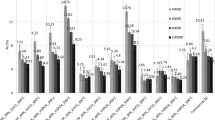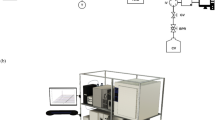Abstract
Activated carbons from spent coffee grounds have been prepared for column adsorption of main green tea polyphenol (−)-epigallocatechingallate (EGCG). The response surface methodology was used to estimate the influence of testing variables on process effectiveness, and a good agreement was found between experimental and predicted data. Adsorption of EGCG occurred in a high ratio, and desorption process in predominantly water solutions was proven to be feasible, and thus, it recovered more than 80 % of the polyphenols. Further, the adsorbent has expressed the selectivity property, revealing the removal of EGCG in much higher content compared to other polyphenol’s group. Obtained fractions of recovered EGCG have undergone just a slight bioactive loss, indicating that such adsorption/desorption performance was mild and appropriate for product stabilization. The kinetic data followed the pseudo-second-order model, and the equilibrium data fitted very well in a Freundlich isotherm equation. The investigation into binding of EGCG from green tea extract revealed that transfer of the results from model experiments to more complex real food systems may be feasible. The favorable results from the overall process suggest that coffee residues may be promising alternatives to organic resins for polyphenols recovery through improved cost efficiency.






Similar content being viewed by others
References
Michailof C, Stavropoulos GG, Panayiotou C (2008) Enhanced adsorption of phenolic compounds, commonly encountered in olive mill wastewaters, on olive husk derived activated carbons. Bioresour Technol 99(14):6400–6408
Kammerer J, Schweizer C, Carle R, Kammerer DR (2011) Recovery and fractionation of major apple and grape polyphenols from model solutions and crude plant extracts using ion exchange and adsorbent resins. Int J Food Sci Technol 46(8):1755–1767
Gogoi P, Saikia MD, Dutta NN, Rao PG (2010) Adsorption affinity of tea catechins onto polymeric resins: interpretation from molecular orbital theory. Biochem Eng J 52(2–3):144–150
Liu Y, Bai Q, Lou S, Di D, Li J, Guo M (2012) Adsorption characteristics of (−)-epigallocatechin gallate and caffeine in the extract of waste tea on macroporous adsorption resins functionalized with chloromethyl, amino, and phenylamino groups. J Agric Food Chem 60(6):1555–1566
Zhao R, Yan Y, Li M, Yan H (2008) Selective adsorption of tea polyphenols from aqueous solution of the mixture with caffeine on macroporous crosslinked poly(N-vinyl-2-pyrrolidinone). React Funct Polym 68(3):768–774
Sajilata M, Bajaj PR, Singhal R (2008) Tea polyphenols as nutraceuticals. Compr Rev Food Sci Food Saf 7(3):229–254
Gao R, Liu H, Peng Z, Wu Z, Wang Y, Zhao G (2012) Adsorption of (−)-epigallocatechin-3-gallate (EGCG) onto oat β-glucan. Food Chem 132(4):1936–1943
Altıok E, Bayçın D, Bayraktar O, Ülkü S (2008) Isolation of polyphenols from the extracts of olive leaves (Olea europaea L.) by adsorption on silk fibroin. Sep Purif Technol 62(2):342–348
Conidi C, Cassano A, Drioli E (2011) A membrane-based study for the recovery of polyphenols from bergamot juice. J Membr Sci 375(1–2):182–190
El-Abbassi A, Hafidi A, García-Payo MC, Khayet M (2009) Concentration of olive mill wastewater by membrane distillation for polyphenols recovery. Desalination 245(1–3):670–674
Boussetta N, Lanoisellé J-L, Bedel-Cloutour C, Vorobiev E (2009) Extraction of soluble matter from grape pomace by high voltage electrical discharges for polyphenol recovery: effect of sulphur dioxide and thermal treatments. J Food Eng 95(1):192–198
Garcia-Castello E, Cassano A, Criscuoli A, Conidi C, Drioli E (2010) Recovery and concentration of polyphenols from olive mill wastewaters by integrated membrane system. Water Res 44(13):3883–3892
Bertin L, Ferri F, Scoma A, Marchetti L, Fava F (2011) Recovery of high added value natural polyphenols from actual olive mill wastewater through solid phase extraction. Chem Eng J 171(3):1287–1293
Loginov M, Boussetta N, Lebovka N, Vorobiev E (2013) Separation of polyphenols and proteins from flaxseed hull extracts by coagulation and ultrafiltration. J Membr Sci 442:177–186
Sun L, Guo Y, Fu C, Li J, Li Z (2013) Simultaneous separation and purification of total polyphenols, chlorogenic acid and phlorizin from thinned young apples. Food Chem 136(2):1022–1029
Xu J, Tan T, Janson J-C (2007) One-step purification of epigallocatechin gallate from crude green tea extracts by mixed-mode adsorption chromatography on highly cross-linked agarose media. J Chromatogr A 1169(1):235–238
Pavlović MD, Buntić AV, Šiler-Marinković SS, Dimitrijević-Branković SI (2013) Ethanol influenced fast microwave-assisted extraction for natural antioxidants obtaining from spent filter coffee. Sep Purif Technol 118:503–510
Amini M, Younesi H, Bahramifar N (2009) Biosorption of nickel(II) from aqueous solution by Aspergillus niger: response surface methodology and isotherm study. Chemosphere 75(11):1483–1491
Rivera-Utrilla J, Bautista-Toledo I, Ferro-García MA, Moreno-Castilla C (2001) Activated carbon surface modifications by adsorption of bacteria and their effect on aqueous lead adsorption. J Chem Technol Biot 76(12):1209–1215
Kousha M, Daneshvar E, Dopeikar H, Taghavi D, Bhatnagar A (2012) Box–Behnken design optimization of Acid Black 1 dye biosorption by different brown macroalgae. Chem Eng J 179:158–168
Amarowicz R, Pegg RB, Rahimi-Moghaddam P, Barl B, Weil JA (2004) Free-radical scavenging capacity and antioxidant activity of selected plant species from the Canadian prairies. Food Chem 84(4):551–562
Liu Y-H, Lin S-Y, Lee C-C, Hou W-C (2008) Antioxidant and nitric oxide production inhibitory activities of galacturonyl hydroxamic acid. Food Chem 109(1):159–166
Datta C, Dutta A, Dutta D, Chaudhuri S (2011) Adsorption of polyphenols from ginger rhizomes on an anion exchange resin Amberlite IR-400—study on effect of pH and temperature. Procedia Food Sci 1:893–899
Ferri F, Bertin L, Scoma A, Marchetti L, Fava F (2011) Recovery of low molecular weight phenols through solid-phase extraction. Chem Eng J 166(3):994–1001
Altok E (2011) Recovery of phytochemicals (having antimicrobial and antioxidant characteristics) from local plants. Unpublished doctoral dissertation, Graduate School of Engineering and Sciences of İzmir Institute of Technology, İzmir, Turkey
Li C, Zheng Y, Wang X, Feng S and Di D (2011) Simultaneous separation and purification of flavonoids and oleuropein from Olea europaea L. (olive) leaves using macroporous resin. J Sci Food Agric 91(15):2826–2834
Wu Z, Li H, Ming J, Zhao G (2010) Optimization of adsorption of tea polyphenols into oat β-glucan using response surface methodology. J Agric Food Chem 59(1):378–385
Singha B, Das SK (2012) Removal of Pb(II) ions from aqueous solution and industrial effluent using natural biosorbents. Environ Sci Pollut Res 19(6):2212–2226
Ahmad MA, Rahman NK (2011) Equilibrium, kinetics and thermodynamic of Remazol Brilliant Orange 3R dye adsorption on coffee husk-based activated carbon. Chem Eng J 170(1):154–161
Reffas A, Bernardet V, David B, Reinert L, Lehocine MB, Dubois M, Batisse N, Duclaux L (2010) Carbons prepared from coffee grounds by H3PO4 activation: characterization and adsorption of methylene blue and Nylosan Red N-2RBL. J Hazard Mater 175(1):779–788
Wang N, Lim L-T (2012) Fourier transform infrared and physicochemical analyses of roasted coffee. J Agric Food Chem 60(21):5446–5453
Kante K, Nieto-Delgado C, Rangel-Mendez JR, Bandosz TJ (2012) Spent coffee-based activated carbon: specific surface features and their importance for H2S separation process. J Hazard Mater 201:141–147
Khitrin K, Khitrin S, Fuks S, Meteleva D and Vtyurina E (2012) Effect of physical and chemical modification on the sorption capacity of hydrolyzed lignin. Russ J Appl Chem 85(8):1197–1200
Cansado I, Mourão P, Falcão A, Carrott M, Carrott P (2012) The influence of the activated carbon post-treatment on the phenolic compounds removal. Fuel Process Technol 103:64–70
Srivastava VC, Mall ID, Mishra IM (2006) Characterization of mesoporous rice husk ash (RHA) and adsorption kinetics of metal ions from aqueous solution onto RHA. J Hazard Mater 134(1):257–267
Yoon SY, Choi WJ, Park JM, Yang J-W (1997) Selective adsorption of flavonoid compounds from the leaf extract of Ginkgo bilobaL. Biotechnol Tech 11(8):553–556
Silva E, Pompeu D, Larondelle Y, Rogez H (2007) Optimisation of the adsorption of polyphenols from Inga edulis leaves on macroporous resins using an experimental design methodology. Sep Purif Technol 53(3):274–280
Scordino M, Di Mauro A, Passerini A, Maccarone E (2004) Adsorption of flavonoids on resins: cyanidin 3-glucoside. J Agric Food Chem 52(7):1965–1972
Reddy D, Seshaiah K, Reddy A, Rao MM, Wang M (2010) Biosorption of Pb2+ from aqueous solutions by Moringa oleifera bark: equilibrium and kinetic studies. J Hazard Mater 174(1):831–838
Kumar KV, Sivanesan S (2005) Prediction of optimum sorption isotherm: comparison of linear and non-linear method. J Hazard Mater 126(1):198–201
Ena A, Pintucci C, Carlozzi P (2012) The recovery of polyphenols from olive mill waste using two adsorbing vegetable matrices. J Biotechnol 157(4):573–577
Gao ZP, Yu ZF, Yue TL, Quek SY (2013) Adsorption isotherm, thermodynamics and kinetics studies of polyphenols separation from kiwifruit juice using adsorbent resin. J Food Eng 116(1):195–201
Soto ML, Moure A, Domínguez H, Parajó JC (2011) Recovery, concentration and purification of phenolic compounds by adsorption: a review. J Food Eng 105(1):1–27
Achak M, Hafidi A, Ouazzani N, Sayadi S, Mandi L (2009) Low cost biosorbent “banana peel” for the removal of phenolic compounds from olive mill wastewater: kinetic and equilibrium studies. J Hazard Mater 166(1):117–125
Gundogdu A, Duran C, Senturk HB, Soylak M, Ozdes D, Serencam H, Imamoglu M (2012) Adsorption of phenol from aqueous solution on a low-cost activated carbon produced from tea industry waste: equilibrium, kinetic, and thermodynamic study. J Chem Eng Data 57(10):2733–2743
Vijayaraghavan K, Han MH, Choi SB, Yun Y-S (2007) Biosorption of Reactive black 5 by Corynebacterium glutamicum biomass immobilized in alginate and polysulfone matrices. Chemosphere 68(10):1838–1845
Vadivelan V, Kumar KV (2005) Equilibrium, kinetics, mechanism, and process design for the sorption of methylene blue onto rice husk. J Colloid Interface Sci 286(1):90–100
Wu F-C, Tseng R-L, Juang R-S (2009) Initial behavior of intraparticle diffusion model used in the description of adsorption kinetics. Chem Eng J 153(1):1–8
Graham HN (1992) Green tea composition, consumption, and polyphenol chemistry. Prev Med 21(3):334–350
Acknowledgments
The financial support for this investigation given by Ministry of Science and Education of the Republic of Serbia under the project TR 31035 is gratefully acknowledged.
Conflict of interest
None.
Compliance with Ethics Requirements
This article does not contain any studies with human or animal subjects.
Author information
Authors and Affiliations
Corresponding author
Rights and permissions
About this article
Cite this article
Pavlović, M.D., Buntić, A.V., Šiler-Marinković, S.S. et al. Recovery of (−)-epigallocatechingallate (EGCG) from aqueous solution by selective adsorption onto spent coffee grounds. Eur Food Res Technol 241, 399–412 (2015). https://doi.org/10.1007/s00217-015-2472-4
Received:
Revised:
Accepted:
Published:
Issue Date:
DOI: https://doi.org/10.1007/s00217-015-2472-4




